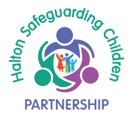Child Sexual Abuse
When a child or young person is sexually abused, they’re forced, tricked or manipulated into sexual activities. They might not understand that what’s happening is abuse or that it’s wrong for the abuser to do this to them. They might be afraid to tell someone or behave as though this is normal for them to experience, both are valid for the child to be displaying. Sexual abuse can happen anywhere – and it can happen in person or online.
In Halton, professionals can access the Child Sexual Abuse Multi-agency strategy and Guidance 2024-2026
Find out more about signs, types, effects and support from NSPCC CSA
Here is a free, short, accessible course from the Centre of Expertise on Child Sexual Abuse, for all professionals working with children on Identifying and responding to intra-familial CSA.
It takes just 90 minutes to complete, is entirely free and consists of three engaging modules, with interactive tasks, video explainers and a final assessment.
It’s designed for professionals at all stages of their career; for those new to safeguarding, or as a helpful refresher Centre of Expertise eLearning – Identifying & responding to intra-familial CSA
There are a number of CSA tools available free of charge from the Centre of Expertise.
For Social Workers the Centre of Expertise also provide a SW CSA Assessment Tool Nov 2024 and 7 min guide to SW Intrafamilial Child Sexual Abuse Assessment Tool
The Child Sexual Abuse Response Pathway highlights good practice when there are concerns that a child or young person is being or has been sexually abused. It aims to bring clarity to professionals’ responsibilities and actions at key points to meet children’s needs for safety and support and address their wider wellbeing.
What is harmful sexual behaviour?
Harmful sexual behaviour has been defined as sexual behaviour by under-18s that is “developmentally inappropriate, may be harmful towards self or others and/or be abusive towards another child, young person or adult”. Those either exhibiting or being harmed by such behaviours may be male or female. Behaviour that is ‘developmentally appropriate’ in young children may be concerning in adolescence, while other behaviours, normal in adolescence, would be worrying in younger children.
Children with learning disabilities or autism
Children and young people with learning disabilities are more vulnerable both to being sexually abused and to displaying inappropriate or problematic sexual behaviour. However, it is likely that the high level of adult supervision of children and young people with learning disabilities means that their sexual behaviour is more likely to be observed and problematised.
Some children and young people with learning disabilities may be more likely to display harmful sexual behaviour as they may having less understanding that some sexual behaviours are not acceptable, and fewer opportunities to establish acceptable sexual relationships. They may also receive less sex education; struggle with social skills; and relate more easily to children younger than themselves.
Prevention
Most prevention-focused activity takes the form of school-based programmes to raise awareness of; sexual exploitation, internet safety, consent and sexual harassment, and to promote healthy relationships. The rationale is generally that unhealthy attitudes and behaviours need to be addressed early, at an individual and at community and societal levels.
Interventions
Interventions, like assessments should be proportionate to the nature and extent of the behaviour, and to the child or young person’s age and developmental stage; joined-up, multi-agency working and discussion is needed, to avoid agencies under- or overreacting to harmful sexual behaviour.
There are various assessments that are used when we have concerns about HSB. Some of these include AIM and the Sexual Behaviours Traffic Light Tool by Brook. Both of these tools require practitioners to be trained in the use of the assessments/screenings.
Halton and their Pan-Cheshire Partners have adopted the ERASE TOOL which has been developed by St Helens Safeguarding Children Partnership and have kindly given their permission to its adaptation to reflect local pathways.
This tool should only be used once you have attended a ERASE Briefing or Harmful Sexual Behaviour Training or you are being supported by a Safeguarding Lead who has undertaken this training.
There are instructions on how to use the tool, but if you are in any doubt, please speak to your manager or safeguarding lead.
Please note, St Helens have no objections in the sharing/circulation of this tool – but in these circumstances; have no responsibility in relation to the use of this tool.

